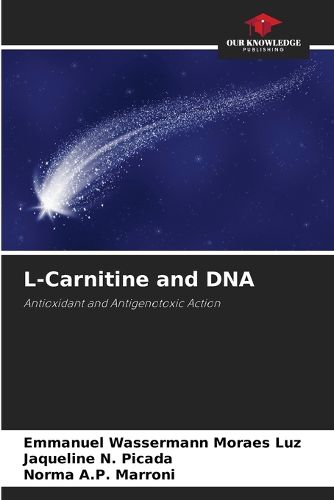Readings Newsletter
Become a Readings Member to make your shopping experience even easier.
Sign in or sign up for free!
You’re not far away from qualifying for FREE standard shipping within Australia
You’ve qualified for FREE standard shipping within Australia
The cart is loading…






L-carnitine (LC) is a quaternary amine that plays a fundamental role in cellular energy production, as it acts in the transfer of long-chain free fatty acids from the cytosol to the mitochondria, facilitating their oxidation and the production of adenosine triphosphate (ATP). In order to evaluate the antioxidant, genotoxic, and antigenotoxic activities of LC in mice, male mice were used in the experiment and divided into four groups, each with seven animals. LC was administered intraperitoneally, and lipoperoxidation (LPO) was evaluated using the TBARS method. Antioxidant activity was evaluated using the enzymes superoxide dismutase and catalase. With lower doses of L-carnitine, there were increases in SOD and CAT, and at higher doses, a decrease in these same enzymes was observed, suggesting lipid peroxidation based on the TBARS test results. LC at all doses used in the comet assay in blood and liver showed no genotoxic activity; on the other hand, it reduced oxidative damage generated by hydrogen peroxide, suggesting antigenotoxic action. Therefore, this book is intended for biologists, geneticists, and anyone who uses the comet assay for analysis.
$9.00 standard shipping within Australia
FREE standard shipping within Australia for orders over $100.00
Express & International shipping calculated at checkout
Stock availability can be subject to change without notice. We recommend calling the shop or contacting our online team to check availability of low stock items. Please see our Shopping Online page for more details.
L-carnitine (LC) is a quaternary amine that plays a fundamental role in cellular energy production, as it acts in the transfer of long-chain free fatty acids from the cytosol to the mitochondria, facilitating their oxidation and the production of adenosine triphosphate (ATP). In order to evaluate the antioxidant, genotoxic, and antigenotoxic activities of LC in mice, male mice were used in the experiment and divided into four groups, each with seven animals. LC was administered intraperitoneally, and lipoperoxidation (LPO) was evaluated using the TBARS method. Antioxidant activity was evaluated using the enzymes superoxide dismutase and catalase. With lower doses of L-carnitine, there were increases in SOD and CAT, and at higher doses, a decrease in these same enzymes was observed, suggesting lipid peroxidation based on the TBARS test results. LC at all doses used in the comet assay in blood and liver showed no genotoxic activity; on the other hand, it reduced oxidative damage generated by hydrogen peroxide, suggesting antigenotoxic action. Therefore, this book is intended for biologists, geneticists, and anyone who uses the comet assay for analysis.